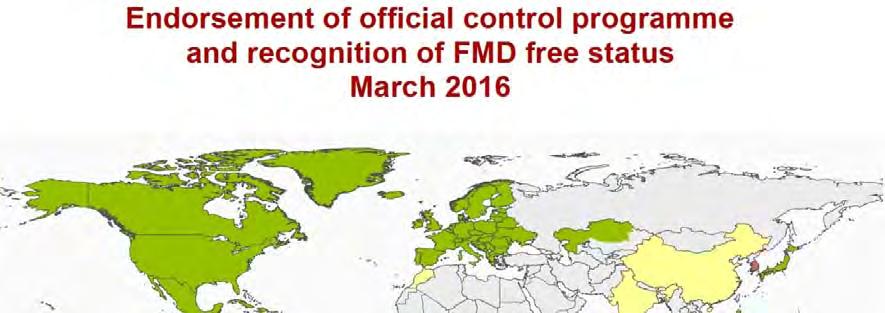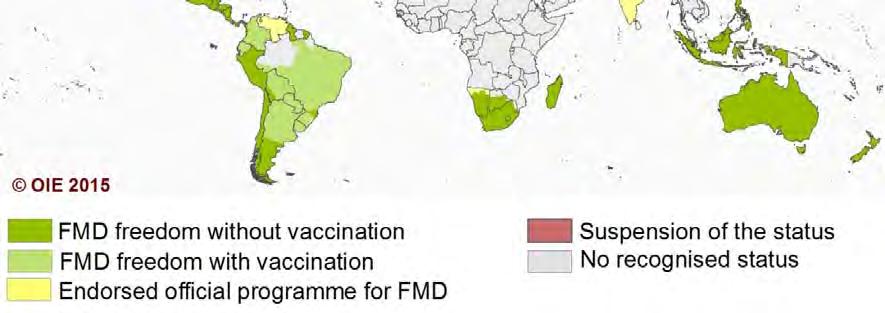
6 minute read
Item 6: Items proposed by Gf-TADs Partners
from 91st Session of the Executive Committee of the European Commission for the Control of Foot-and-Mouth
by EuFMD
Item 6: Items proposed by Gf-TADS Partners
A joint presentation (Appendix 10) by Juan Lubroth (FAO), Jean Pierre Dop (OIE) and Alessandro Ripani (OIE). Dr Lubroth started with an overview of the FAO support to FMD control, which supports the reduction of risk to EuFMD member states. In 2015, FAO through Technical Cooperation Projects (TCP), Trust Funds (TF) has supported FMD control in various regions of the world. This included Emergency assistance or support on FMD control in North Korea, Uganda and Zimbabwe; Development of National Control Program for Foot and Mouth Disease in Pakistan; Building resilience and self-reliance of livestock keepers by improving control of Foot-and-Mouth Disease (FMD) and other Transboundary Animal Diseases (TADs) – Afghanistan; Foot-and-Mouth Disease Control in Southeast Asia through Application of the Progressive Control Pathway", within the framework of "Improving National Preparedness for Transboundary Animal Infectious Disease in
Advertisement
Developing Countries in Southeast Asia".
As well as numerous projects on strengthening of the veterinary services which are in line with the 3rd component of the Global Strategy for FMD control. Since 2012, 11 regional roadmap meetings were convened in Asia and Africa. This is supporting gradual control of FMD by the approach of the PCP-FMD.


Figure 3, Regional roadmaps convened since 2012
With regard to the Global Strategy for FMD control, Lubroth indicated that global FMD control seems feasible and that the PCP-FMD approach and the reinforcement of veterinary systems are gradually gaining acceptance. Currently, 60 countries are engaged and 42 countries are closely monitored with notable evidence of advancement. However, political will and engagement of international and regional organizations and development partners are crucial to the startup and sustainability of FMD control and funding is needed to support the global strategy, particularly those countries at lower PCP stages. A welcome development was that roadmap meetings are being attended by third parties especially in West Eurasia and East Africa which may be a show of interest by potential donors.
Concurrently, these meetings demonstrate challenges in different areas such as diagnostics (for instance the capabilities to carry out sustainable surveillance, field investigations and collection and shipping of samples, laboratory biosafety and biosecurity and equipment and reliable flow of diagnostic supplies) and on vaccine and vaccination related issues such as low coverage, vaccination regimens for small ruminants, risk-based vaccination programs and use of good quality vaccine.
Regional plans are necessary to address FMD control for hot-spots in regional ecosystem and their (re-) emergence), to establish concerted regional control plan with examples in Southern America (PHEFA) and South-East Asia (SEACFMD) and to understand animal movement patterns and value chains between countries within a region. Dr Juan Lubroth emphasized the need to be able to convince decision-makers on allocating budget on animal health related issues. FMD control is one of a number of competing priorities and may be overlooked given other disease concerns. Dr Jean-Pierre Dop continued the presentation with listing the priorities for the FAO/OIE FMD Working Group in 2016. These started with PCP Training for FAO and OIE staff to improve the awareness, and increase the appropriate application of the
PCP-FMD tool, to clarify the link between the PCP-FMD and PVS tools under the component 2 of the Global
Strategy and to clarify the relation between the PCP-FMD tool and the OIE procedure for endorsement of official control programme for FMD and for recognition of FMD free status. The ultimate goal is to have all regional / sub-regional officers being able to provide guidance to countries and to better follow-up their respective regional roadmap. For the long-term to have regional officers apply such risk management approaches to other threats of animal origin. Revision of the PCP-FMD guidelines and associated questionnaires, by building on the experiences gained and to include Component 2 of the FMD Global Strategy (Strengthening Veterinary Services) Guiding materials for FMD control plans required such as templates for control plans - to support countries willing to progress to PCP Stages 1, 2 and 3 and to advance in their PCP stage. Examples are the postvaccination monitoring (PVM) guidelines (soon to be published) and the socio-economic guidelines, to guide countries to: Need for Regional Leading Laboratories in particular in North Africa, Eastern African and Western Africa. These need to be rrecognized and nominated by the region while support may be expected from the Working Group to the process of drafting criteria and development of the nomination process. Such Regional Leading
Laboratory will benefit the region by facilitating access to training and diagnostic reagents and proficiency testing.
[Note on the last: the OIE/FAO Working Group had agreed Regional Support Laboratories in 2013 to be: Kenya (Embakasi), Ethiopia (NAHDIC), Nigeria (Vom), and Senegal, based on nominations from the regions. On this basis EuFMD had provided support under its component 3.3. These cover East and West Africa only].
Dr Jean-Pierre Dop continued to outline the OIE activities relevant to FMD control at global level. He referred to the current revision of the Code and Manual on international standards. Additionally, Dr Dop mentioned the update of official status recognition and endorsement of official control programs. As can be seen from the global map in Figure 4, the endorsed status of Algeria was withdrawn recently (February 2016) after withdrawal of the Tunisia endorsed control programme in September 2014. An OIE steering committee is currently elaborating the details of establishing OIE supported vaccine banks.


Figure 4, Endorsement and recognition
Dr Alessandro Ripani from the OIE sub-regional representation for North Africa in Tunis, Tunisia continued to present FMD activities in North Africa. He started with reviewing the FMD situation in the region. Serotype O, strain O/ME-SA/Ind-2001 started circulating in 2014 in Tunisia and Algeria after previously being introduced in Libya in 2013. In November 2015, this strain was detected in Morocco. It seems likely that this strain originates from the Indian subcontinent and has reached North Africa through trading routes in which the Middle East is involved. Serotype SAT2 was notified in Mauritania in 2015, 9 years after the previous FMD notification from Mauretania.
The lessons learnt from the FMD epidemic in North Africa are the difficulties to contain animal movements between and within countries affected. This involves difficulties with raising awareness with animal traders, with having appropriate vaccines available immediately and difficulties in implementing regular active surveillance in the affected countries. Obviously, the political instability in Libya is posing a challenge for a regional approach to control.
Dr Ripani continued to elaborate about the REMESA activities, in particular on the decision by the Joint Permanent Committee (JPC) during the 9th meeting held in Tunis. The OIE was entrusted by REMESA Countries to implement a regional bank for North Africa of vaccines and antigens for FMD to allow access to high quality vaccines or antigens for the countries of the Region complying with intergovernmental standards - in particular in emergency situation - through an international call for tender prepared by the OIE. This project is in progress and the countries recommended to establish a specific steering committee for the vaccine bank that would associate REMESA member countries with representatives of the UMA secretariat, FAO sub regional office for North Africa, EuFMD as well as donors. At the last JPC meeting in Algiers (24-25 November 2015), the importance of establishing a regional vaccine bank for FMD in the REMESA region was re-iterated, along with a harmonized vaccination strategy among the countries and an effective livestock animal identification (traceability of the animal movements). Based on these recommendations, OIE office in Tunis plans to organize a workshop dedicated to elaborate and to be agreed on a harmonized and feasible vaccination strategy for FMD to be presented at the next REMESA meeting. The major elements to be discussed and agreed during the workshop are as follows: Which species need



